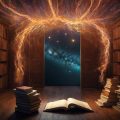1. Introduction to Lucid Dreaming in American Culture
Lucid dreaming is a fascinating experience where people become aware that they are dreaming while still inside the dream. In recent years, this topic has gained widespread attention across the United States, both in popular culture and within scientific communities. Americans are increasingly curious about how lucid dreams can be used for personal growth, creativity, and even spiritual exploration.
What is Lucid Dreaming?
At its core, lucid dreaming happens when you realize you are dreaming and sometimes can even control what happens in your dream. This unique state of consciousness often feels vivid and real, making it different from ordinary dreams where people usually remain passive observers.
Why Are Americans Interested in Lucid Dreaming?
The rising interest in lucid dreaming in the U.S. can be linked to several factors:
| Reason | Description |
|---|---|
| Self-Discovery | Many Americans see lucid dreams as a tool to better understand themselves and their subconscious minds. |
| Stress Relief | Practicing lucid dreaming is seen as a way to process daily stress or anxiety in a safe environment. |
| Creativity Boost | Artists and writers use lucid dreams to find inspiration and new ideas. |
| Metaphysical Exploration | Some believe that lucid dreaming offers insights into deeper questions about reality and existence. |
Connection to Metaphysical Exploration
For many Americans, lucid dreaming isnt just about having fun or escaping reality—its also connected to metaphysical questions. People wonder if their dreams reveal hidden truths about themselves or the universe. Some explore concepts like the soul, parallel realities, or even messages from beyond through these vivid dream experiences. This blend of curiosity, self-improvement, and metaphysical inquiry is helping shape the growing popularity of lucid dreaming in modern American culture.
2. Historical and Cultural Background
The Roots of Lucid Dreaming in American History
Lucid dreaming, or becoming aware that you are dreaming while still in the dream, has fascinated Americans for generations. While lucid dreaming is a universal phenomenon, different American communities have explored its metaphysical meanings in their own unique ways. From Native American traditions to modern spiritual movements, the American approach to lucid dreaming reflects a blend of cultures, beliefs, and evolving ideas about consciousness.
Indigenous Perspectives on Lucid Dreaming
Many Native American tribes have long viewed dreams as powerful sources of guidance and spiritual insight. In some cultures, dreams were believed to connect individuals with ancestors or spirit guides. Lucid dreams were sometimes interpreted as special messages or opportunities for healing and personal growth.
| Community | Belief about Lucid Dreams |
|---|---|
| Ojibwe (Anishinaabe) | Dreams as visions; lucid experiences seen as contact with spirits |
| Navajo | Dreams guide daily life; certain dreams considered sacred |
| Pueblo Peoples | Dreams reveal instructions from spiritual beings |
Influence of 19th and 20th Century Spiritual Movements
In the late 1800s and early 1900s, America saw a rise in interest in metaphysical topics like hypnosis, astral projection, and dream interpretation. The New Thought movement and Theosophy encouraged people to explore inner consciousness through lucid dreaming. These groups believed dreams could offer access to hidden knowledge and even alternate realities.
Metaphysical Communities and Lucid Dreaming Practices
- Theosophists: Used lucid dreaming as a tool for spiritual exploration and self-discovery.
- New Age Seekers: Saw lucid dreams as pathways for manifestation and personal transformation.
- Psychedelic Culture (1960s-1970s): Viewed lucid dreams alongside altered states of consciousness as gateways to understanding reality beyond the physical world.
Modern American Approaches: Mainstream & Subcultures
Today, lucid dreaming is discussed both scientifically and spiritually across America. Popular psychology focuses on self-improvement, creativity, and overcoming nightmares through conscious dreaming. At the same time, metaphysical communities—like those interested in energy work or astral travel—continue to interpret lucid dreams as spiritual journeys or encounters with non-physical realms.
| Group/Subculture | Main Focus in Lucid Dreaming | Cultural Impact |
|---|---|---|
| Mainstream Psychology | Mental health, creativity, problem-solving | Popular apps, therapy practices, books |
| Metaphysical Groups | Spiritual growth, astral travel, contacting guides | Workshops, online forums, podcasts |
| LGBTQ+ & Counterculture Circles | Exploring identity and safe spaces within dreams | Zines, art projects, community sharing events |
| Youth & Online Communities (Reddit, TikTok) | Sharing tips for dream control; exploring metaphysics playfully | Meme culture, viral challenges, educational threads |
The Evolving Dialogue Around Lucid Dreams in America
No matter the background or belief system, Americans continue to find meaning in lucid dreams—sometimes as tools for personal empowerment, other times as portals into the mysteries of existence. This diversity shapes an ongoing conversation about what it means to be awake within our own minds and what we might discover there.

3. Modern Interpretations of Metaphysical Experiences
Today, many Americans approach metaphysical experiences in lucid dreams with a blend of curiosity and open-mindedness. While some people see these dreams through a spiritual lens, others look to psychology for explanations. Let’s explore how different groups within American culture interpret the metaphysical meanings found in lucid dreaming.
Psychological Perspectives
From a psychological standpoint, lucid dreams are often viewed as opportunities for self-discovery and personal growth. Psychologists may suggest that metaphysical experiences—like meeting spiritual beings or traveling to other realms—are reflections of the subconscious mind. These experiences might help people work through unresolved emotions or gain insight into their waking life challenges.
Common Psychological Interpretations
| Metaphysical Dream Experience | Psychological Meaning |
|---|---|
| Meeting a higher being | Desire for guidance or reassurance |
| Out-of-body travel | Exploring personal freedom or escape from stress |
| Receiving messages or symbols | Subconscious trying to communicate important insights |
Spiritual Perspectives
On the other hand, many Americans—especially those interested in New Age spirituality—see lucid dreams as gateways to deeper spiritual understanding. They may believe that these dreams allow them to connect with their higher self, spirit guides, or even loved ones who have passed away. For these dreamers, metaphysical experiences are meaningful signs or lessons from the universe.
Spiritual Meanings Assigned by Americans
| Dream Encounter | Possible Spiritual Interpretation |
|---|---|
| Talking with ancestors or guides | Receiving wisdom from beyond the physical world |
| Experiencing light or energy flows | Spiritual awakening or healing process |
| Traveling to otherworldly places | Soul exploration and cosmic connection |
Cultural Blending and Personal Beliefs
The modern American approach is often a blend of both science and spirituality. Many people feel comfortable exploring both perspectives, sometimes combining what feels most meaningful to them personally. This open attitude allows individuals to take what resonates with their beliefs, whether rooted in psychology, religion, or personal intuition.
4. Lucid Dreams as Tools for Personal Insight and Growth
In American culture, lucid dreaming is more than just a fascinating experience—it’s a valuable tool for self-discovery, problem-solving, and spiritual growth. Many Americans actively explore their dreams to find answers to questions about themselves, navigate life challenges, or even unlock creative ideas.
Self-Discovery Through Lucid Dreaming
People across the U.S. often use lucid dreaming as a way to better understand their emotions, motivations, and fears. By becoming aware that they are dreaming, individuals can consciously interact with dream characters or revisit significant memories. This unique perspective helps dreamers gain insight into aspects of themselves that might be hidden in waking life.
Popular Techniques for Lucid Dreaming
| Technique | Description |
|---|---|
| Reality Checks | Frequently questioning if you are dreaming throughout the day (like trying to push your finger through your palm) to build awareness for use in dreams. |
| Dream Journaling | Writing down dreams immediately upon waking up to improve dream recall and recognize patterns. |
| MILD (Mnemonic Induction of Lucid Dreams) | Telling yourself you will realize you’re dreaming before going to sleep, using intention-setting. |
| WBTB (Wake Back To Bed) | Waking up after several hours of sleep and then returning to bed with the aim of entering a lucid dream state more easily. |
Problem-Solving in Lucid Dreams
Americans often use lucid dreams as a space for creative thinking and tackling real-life problems. Artists, writers, and inventors sometimes report working on projects or overcoming creative blocks while aware in their dreams. Everyday people have also found solutions to personal dilemmas by asking direct questions within their dreams or exploring possible outcomes in a safe environment.
Anecdotal Examples from American Dreamers
- A software engineer from California used lucid dreaming techniques to visualize complex code structures and resolved bugs she couldn’t fix during her workday.
- A college student in Texas managed recurring anxiety by confronting dream versions of his stressors, helping him feel more confident during waking hours.
- An artist in New York painted images inspired directly from her lucid dream experiences, giving her art a unique style that resonated with viewers.
Spiritual Growth and Exploration
For many Americans, lucid dreams are an opportunity for spiritual exploration. Some people describe meeting spiritual guides or experiencing feelings of interconnectedness while lucid dreaming. These experiences often lead to greater mindfulness, empathy, and a sense of purpose in daily life.
Summary Table: Ways Americans Use Lucid Dreaming
| Purpose | How It’s Used |
|---|---|
| Self-Discovery | Exploring inner thoughts and emotions through controlled dream experiences. |
| Problem-Solving | Tackling creative or personal challenges within the safe realm of dreams. |
| Spiritual Growth | Seeking meaning or guidance through encounters with symbolic figures or experiences. |
The use of lucid dreaming for personal insight and growth is thriving among Americans who value both scientific curiosity and metaphysical exploration. As interest continues to grow, these practices become even more accessible and meaningful across different communities.
5. Skepticism and Scientific Perspectives
When it comes to lucid dreams and their possible metaphysical meanings, many Americans approach the topic with a healthy dose of skepticism. This attitude is shaped by a culture that often values scientific evidence and critical thinking. While some people are fascinated by the spiritual or mystical aspects of lucid dreaming, others want to know if there’s any proof behind these claims.
American Skepticism Toward Metaphysical Claims
In the United States, skepticism about metaphysical explanations in lucid dreaming usually falls into a few common patterns. People may wonder if these dreams really connect us to other realms or if theyre simply products of our imagination. This skepticism is influenced by American values like rationality, personal freedom, and individual experience.
| Common Metaphysical Claim | Skeptical Response |
|---|---|
| Lucid dreams are gateways to alternate realities. | Are there measurable effects or just vivid imagination? |
| You can communicate with spirits or ancestors during lucid dreams. | Is there any repeatable evidence or is it subjective? |
| Lucid dreams provide spiritual enlightenment. | Is this unique to dreams, or does it happen in waking life too? |
Scientific Community’s Approach
Scientists in America typically examine lucid dreaming through the lens of psychology and neuroscience. Researchers ask questions like: What happens in the brain during lucid dreaming? Can we measure changes in brainwaves? Does lucid dreaming have mental health benefits?
How Scientists Study Lucid Dreams
- Sleep Labs: Volunteers sleep while hooked up to machines that track their brain activity. Researchers look for patterns that show when someone becomes “lucid.”
- Surveys and Journals: People report their dream experiences, helping scientists spot trends or common features among lucid dreamers.
- Mental Health Studies: Some researchers explore whether practicing lucid dreaming can help with nightmares, anxiety, or creativity.
The Balance Between Belief and Evidence
The American perspective on metaphysical meanings in lucid dreams is shaped by a mix of curiosity and skepticism. While some embrace spiritual interpretations, many look for solid evidence before accepting extraordinary claims. Scientific research continues to investigate these experiences, aiming to separate what’s possible from what’s purely imaginative.


